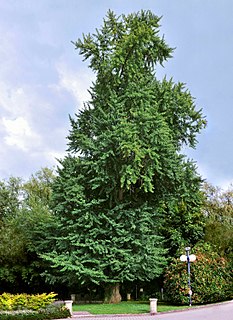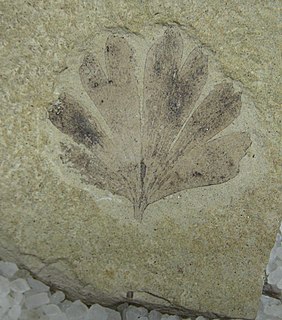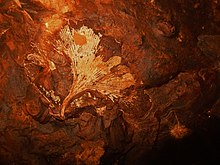
Ginkgo biloba, commonly known as ginkgo or gingko also known as the maidenhair tree, is a species of tree native to China. It is the last living species in the order Ginkgoales, which first appeared over 290 million years ago. Fossils very similar to the living species, belonging to the genus Ginkgo, extend back to the Middle Jurassic approximately 170 million years ago. The tree was cultivated early in human history and remains commonly planted.

Ginkgoales are a gymnosperm order containing only one extant species: Ginkgo biloba, the ginkgo tree. It is monotypic, within the class Ginkgoopsida, which itself is monotypic within the division Ginkgophyta. The order includes five families, of which only Ginkgoaceae remains extant.

Weald Clay or the Weald Clay Formation is a Lower Cretaceous sedimentary rock unit underlying areas of South East England, between the North and South Downs, in an area called the Weald Basin. It is the uppermost unit of the Wealden Group of rocks within the Weald Basin, and the upper portion of the unit is equivalent in age to the exposed portion of the Wessex Formation on the Isle of Wight. It predominantly consists of thinly bedded mudstone. The un-weathered form is blue/grey, and the yellow/orange is the weathered form, it is used in brickmaking.
The North American land mammal ages (NALMA) establishes a geologic timescale for North American fauna beginning during the Late Cretaceous and continuing through to the present. These periods are referred to as ages or intervals and were established using geographic place names where fossil materials were obtained.
Glyptopomus is an extinct genus of prehistoric sarcopterygian or lobe-finned fish.

Ginkgo dissecta is an extinct ginkgo species in the family Ginkgoaceae described from a series of isolated fossil leaves. The species is known from Early Eocene sediments exposed in the province of British Columbia, Canada, and Washington, USA. It is one of two Ginkgo species found at the Washington and British Columbia sites.

Ginkgoites is a genus that refers to extinct plants belonging to Ginkgoaceae. Fossils of these plants have been found around the globe during the Triassic, Jurassic, Cretaceous, and Paleocene-age Porcupine Hills Formation in Alberta. The name was created as a form genus in 1919 by Albert Seward who stated: "I ... propose to employ the name Ginkgoites for leaves that it is believed belong either to plants generically identical with Ginkgo or to very closely allied types".
Kallidontus is an extinct genus of conodonts.
Patrognathus is an extinct genus of conodonts.
Clydagnathus is a genus of conodonts in the family Cavusgnathidae. Species are known from the Carboniferous of India and the Devonian of Morocco.

Bauruemys is an extinct genus of turtles in the family Podocnemididae.

Baiera is a genus of prehistoric gymnosperms in the order Ginkgoales. It is one of the oldest fossil foliage types of Ginkgoales, and is related to the genera Ginkgo and Ginkgoites. Fossils of Baiera are found worldwide, and have been known from the Permian to the Cretaceous.
Theroteinus is an extinct genus of haramiyidan mammaliaforms from the Late Triassic of France and Britain. It contains three species: T. nikolai,T. rosieriensis and T. jenkinsi, the former two of which are known exclusively from teeth found at the sand quarry of Saint-Nicolas-de-Port, while T. jenkinsi is known from a bedded sequence belonging to the Westbury Formation in a road cutting near Holwell, Dorset. Theroteinus is the only member of the family Theroteinidae and the suborder Theroteinida.

Sphodrosaurus is an extinct genus of basal archosauriformn reptiles from the Late Triassic-aged New Oxford Formation of Pennsylvania. The type species is S. pennsylvanicus, described by Edwin Colbert in 1960. The holotype consists of a partial skeleton including the back of the skull, the vertebral column, all of the ribs, all of the hindlimbs and part of the upper forelimbs; Sphodrosaurus was originally believed to have been a member of the Procolophonidae while more recently Sphodrosaurus was believed to be a basal member of the Diapsida by most authors starting with Sues et al. (1993), or a member of the Rhynchosauria. In 2022, Ezcurra & Sues redescribed the holotype in detail and placed it in a phylogenetic analysis with other Triassic diapsid reptiles, where it was found as the basalmost doswellid.
Thanatosdrakon is a genus of quetzalcoatline pterosaur from the Late Cretaceous Plottier Formation of the Neuquén Basin in western Argentina. The genus name is derived from the Greek words thanatos (=death) and drakon (=dragon), while the specific name is a Quechuan word meaning "flying serpent" and refers to the Incan deity Amaru. The type and only species is Thanatosdrakon amaru, known from two specimens consisting of several well-preserved axial and appendicular bones including material previously undescribed in giant azhdarchids. Thanatosdrakon is one of the oldest known members of the Quetzalcoatlinae. T. amaru lived from about 90 to 86 million years ago.








